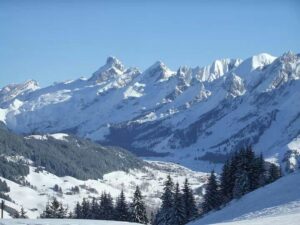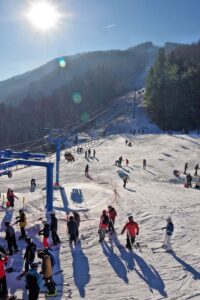Does It Snow in Italy? Explore the Country’s Winter Magic
When most people think of Italy, they imagine bright Mediterranean settings, historic ruins, and mouthwatering cuisine. But does Italy’s snowfall exist? The response is indeed yes. Many parts of Italy have snowfall, particularly in the north and high-altitude regions. From the breathtaking Dolomites to the snow-capped Italian Alps, Italy presents amazing winter activities.
In Italy, winter offers celebrations, comfortable mountain hideaways, and amazing snowy scenery in addition to skiing. Italy provides something for everyone, whether your search is for a cultural experience or an energetic winter adventure.
This book will address Does It Snow in Italy, the finest places for snowfall, winter sports, and basic travel advice for those about to visit.

Italy’s Winter Climate: A Quick Overview
From temperate coastal areas to snow-covered mountain summits, Italy presents a remarkable diversity of winter weather. Italy has plenty to offer every visitor, whether your preferred winter retreat is in the south or a ski trip is in the north. Whether your vacation is planned or you just want to know about snowfall, temperatures, or optimal locations, knowledge about the winter climate of the nation is vital.
Mediterranean vs. Alpine Climate
The winter climate of Italy differs greatly according to the area. There exist three main climate zones in the nation:
- Northern Italy: Long, cold winters with lots of snowfall define this area, which includes the French Alps and The dolomites. Although some cities, such as Milan, Turin, and Bologna, experience snow, mountains are a winter wonderland with persistent snow cover that is perfect for skiing and other winter sports.
- Central Italy: This area boasts a more varied climate. While mountainous regions like the Apennines get a significant amount of snow, which presents chances for winter activities, coastal cities like Rome and Florence have moderate winters with little to no snow.
- Southern Italy and the Islands: Southern Italian winters are rather mild; places like Naples and Palermo hardly ever see snow. Nonetheless, high-altitude regions like Mount Etna in Sicily can still get snowfall, therefore producing a distinctive winter contrast between sunny beaches and snow-capped mountains.
Factors Influencing Snowfall
In Italy, snowfall is determined by a number of topographical and meteorological elements:
- Altitude: Snow is more likely as one increases elevation. Mountains, including the Apennines, Dolomites, and Italian Alps, have regular snowfall all through the winter.
- Latitude: Closer to the Alps, northern Italy has more chance of snow than central and southern parts.
- Proximity to Water: The impact of the Mediterranean Sea causes warmer temperatures in coastal regions, therefore lowering the likelihood of snowfall.
General Winter Temperature Ranges
Winter temperatures in Italy range depending on the area:
- Northern Italy: Usually runs from -5°C to 5°C (23°F to 41°F), with mountain colder temperatures.
- Central Italy: Usually finds temperatures between 0°C and 10°C (32°F and 50°F), with higher elevation snowfall.
- Southern Italy: Mild winters, between 5°C and 15°C (41°F and 59°F), with some snowfall in high-altitude regions.
Whether your Italian winter vacation is for a gentler seasonal escape or snowy fun, knowing these climate fluctuations can help you plan.
Where Does It Snow in Italy? Regional Breakdown
Italy provides amazing winter scenery even though it is sometimes linked with sun-drenched shores and ancient towns. From the less-known skiing areas in the Apennines to the snow-capped heights of the Italian Alps, different parts of Italy see differing degrees of snowfall. Learning where it snows in Italy will enable you to decide the ideal location, whether your trip is scheduled for skiing or just for appreciating a winter paradise.
Northern Italy
Italian Alps and Dolomites
The Italian Alps and Dolomites, where lots of snowfall turns Northern Italy into a winter sports paradise, call home Drawing tourists from all around the world, these great mountains provide some of the best skiing available in Italy.
- Popular Ski Resorts: Cortina d’Ampezzo, Cervinia, Livigno, Madonna di Campiglio, Sestriere.
- Average Snowfall: Dependent on height and weather, it ranges from 2 to 6 meters yearly.
- Winter Activities: Winter trekking, ice climbing, snowboarding, snowshoeing, skiing.
- Best Time to Visit: December to March is the best time to visit since snowfall is ideal for winter activities.
The Italian Alps and Dolomites remain the top choice for a snow-filled vacation in Italy with their world-class ski resorts and sophisticated infrastructure.
Cities in Northern Italy
While cities like Milan, Turin, and Bologna have sporadic snow during winter, the mountains get plenty. Although not as regular as in the Alps, snowfall in these towns produces a lovely winter scene with Christmas markets improving the seasonal appeal, snow-covered streets, and celebratory lights.
Central Italy
Apennine Mountains
The Apennine Mountains, located along Italy’s spine, experience significant snowfall, especially in regions such as Abruzzo, Umbria, and Marche For those looking for a quieter, less crowded substitute for the Alps, these regions provide stunning winter settings.
- The ski resorts are Roccaraso, Campo Felice, Abetone.
- Usually depending on the elevation, snowfall ranges from one to three meters yearly.
- Winter Activities: Scenic winter treks, snowshoeing, and skiing.
Perfect mix of history and winter fun, areas like Abruzzo are renowned for their snow-covered hills and little medieval towns.
Southern Italy and Islands
Coastal Areas
Snowfall is far less in Southern Italy, especially in coastal towns like Naples, Bari, and Palermo. But occasionally flurries or light snowfall might arise during especially cold winters, giving these usually sunny locations an unusual twist.
High-Altitude Areas
Although snow is rare at lower altitudes, higher-altitude southern sites do get snowfall:
-
Mount Etna (Sicily): Mount Etna’s snow-covered slopes offer a special winter sports experience since they are among the few locations worldwide where one may ski on an active volcano.
-
Calabria’s Sila Mountains: Often referred to as a hidden gem for winter sports, this area provides first-rate skiing and breathtakingly beautiful snow-covered scenery distant from the throngs.
For those looking for snow, these high-altitude areas offer a winter wonderland even though Southern Italy and its islands are most known for their Mediterranean environment.

Planning Your Winter Trip to Italy
For those who enjoy snow, Italy becomes a magnificent winter wonderland. Whether your ambition is skiing in the Alps or touring old cities covered with winter appeal, proper travel planning guarantees an unforgettable encounter. From the ideal time to visit for snow to basic packing advice, here’s all you need to know before starting your winter journey in Italy.
Best Time to Visit for Snow
December through March is Italy’s winter; January and February see most snowfall. Particularly in northern areas like the Dolomites and the Italian Alps, these months offer the most continuous snow conditions. This is the perfect time to visit if you are organizing a ski holiday, as resorts are fully run with well-maintained slopes and first-rate amenities. Although there is a happy mood between Christmas and New Year’s, crowds are bigger. Late January and February are the perfect times for a slower winter retreat with plenty of snow.
Getting Around in Winter
Winter navigation of Italy is easy; nonetheless, preparation for snowy conditions is essential.
-
Trains: Between big cities like Milan, Florence, and Rome, Italy’s fast trains—including the Frecciarossa—offer a pleasant and quick means of travel. They are dependable even in winter.
-
Driving: Keep in mind that winter tires or chains are required in some areas even if you are renting a car to see mountain locations or the countryside. Though they can be icy, roads throughout the Swiss Alps and Dolomites are kept rather well.
-
Flights: Easy access to top ski locations comes from Northern Italian airports, including Milan Malpensa and Turin. Many resorts provide shuttle services from several airports, therefore facilitating access to your winter vacation.
What to Pack for Winter in Italy
suitable packing guarantees your comfort and warmth as you enjoy the winter scenes of Italy.
-
Clothing: One must layer everything. Bring gloves, scarves, insulating coats, moisture-wicking thermals, and waterproof boots. If you intend to travel the mountains, you really must have skis.
-
Gear: Given the light reflects off the snow, particularly at high altitudes, sunglasses and sunscreen are shockingly important. Additionally handy are a decent travel-friendly umbrella for unanticipated rain or snow showers and a bag for day travels.
Accommodation Options
Selecting the correct lodging improves your Italian winter vacation.
-
Ski Resorts: If your trip mostly consists of skiing or snowboarding, lodging in a ski resort is the best choice. These hotels have luxurious spas, direct slope access, and après-ski events. World-class amenities and breathtaking Alpine landscapes abound at locations such as Cortina d’Ampezzo and Val Gardena.
-
City Hotels: Staying in a city hotel guarantees comfort and accessibility if you would want to see Italy’s historical and cultural sites. Perfect for savoring winter beauty, cities such as Rome, Florence, and Venice provide little boutiques with fires and friendly welcomes.
Whether you’re skiing or walking across snow-covered piazzas, you may fully appreciate Italy’s winter season with forward planning and wise decision-making.

Beyond Skiing: Other Winter Activities in Italy
Italy is well-known for its first-rate ski resorts, but winter provides far more than just skiing. From amazing snow-covered scenery to vibrant celebrations and mouthwatering seasonal cuisine, Italy offers a wide spectrum of winter sports for visitors wishing to venture outside the slopes.
Winter Hiking and Snowshoeing
Winter hiking and skiing offer an excellent way for nature lovers to see Italy’s breathtaking natural splendor. Well-marked paths via snow-covered forests, frozen lakes, and panoramic views run from the Dolomites and Apennines. A great substitute for skiing, snowshoeing provides a quiet means of seeing unspoiled winter scenery.
Among the best paths are grandmother Sasso National Park in the Apennines, where winter hikers may find detached mountain communities and wildlife, and the Tre Cime di Lavaredo loop in the Dolomites, renowned for its amazing alpine vistas. Having appropriate gear—including impermeable boots, warm clothes, and trekking poles—is crucial before you leave. Ensuring a safe and fun trip requires looking at the weather and having a GPS or map.
Winter Festivals and Events
Italy comes alive in winter with a range of cultural events highlighting regional customs, music, and cuisine.
-
Christmas Markets: Handcrafted items, glittering lights, and seasonal delicacies like panettone and strudel abound in the most magical Christmas markets held in Bolzano and Milan.
-
Venice Carnival: Held in February, this international celebration changes the city with extravagant masks, dramatic presentations, and huge parades across the canals and old squares.
-
Alpine Festivals: Winter celebrations in the alpine areas honor regional foods, traditions, and classic music. Unique cultural events abound, from the Saint Lucia Festival in Trentino to the Krampus Run in South Tyrol.
Winter Food and Drink
Italy’s winter food is rich and consoling, with substantial dishes meant to soothe the spirit. Visitors can savor regional delights including:
-
Polenta: Often presented with melted cheese or slow-cooked meats, a classic northern Italian meal.
-
Risotto: Winter classics are variations like Risotto alla Milanese (saffron risotto) and Risotto al Tartufo (truffle risotto).
-
Hearty Stews: Slow-cooked dishes like Brasato al Barolo (beef braised in red wine) and Cassoeula (pork and cabbage stew) provide warmth during chilly days.
For drinks, winter in Italy wouldn’t be complete without Vin Brulé, a spiced hot wine popular at Christmas markets and ski slopes. Another must-try is Italian hot chocolate, famed for its rich, creamy texture, commonly savored with biscotti or pandoro.
Whether you’re hiking through snow-covered mountains, witnessing bright festivals, or relishing Italy’s rich winter flavors, there’s no shortage of ways to enjoy the colder months beyond skiing.
Conclusion
Italy becomes a stunning winter wonderland with a mix of exciting outdoor pursuits and magical cultural encounters. Italy in winter has something for everyone, whether your inclination is toward the snow-covered heights of the Italian Alps or the celebratory energy of ancient cities.
Adventurers will find world-class skiing, snowboarding, and other winter activities in the Italian Alps and Dolomites. Perfect slopes, breathtaking mountain vistas, and opulent après-ski experiences abound at resorts such as Cortina d’Ampezzo and Val Gardena. Snowshoeing and sledding offer other opportunities to appreciate the icy surroundings even if skiing is not your passion.
Beyond the Alps, Italy’s towns have a winter magical appeal. As Rome, Florence, and Venice empty out, guests may now more leisurely visit famous sites. Cozy and festive environment is produced by the snow-dusted streets, glittering lights, and seasonal markets. Traditional Christmas markets in northern areas like Trentino-Alto Adige offer warmth and delight with locally produced crafts, mouthwatering cuisine, and mulled wine.
Italy’s winter season provides unique experiences regardless of your taste in outdoor adventures or a quiet getaway surrounded with history and culture. Plan your trip and let the splendor of Italy’s snowy paradise envelop you!




